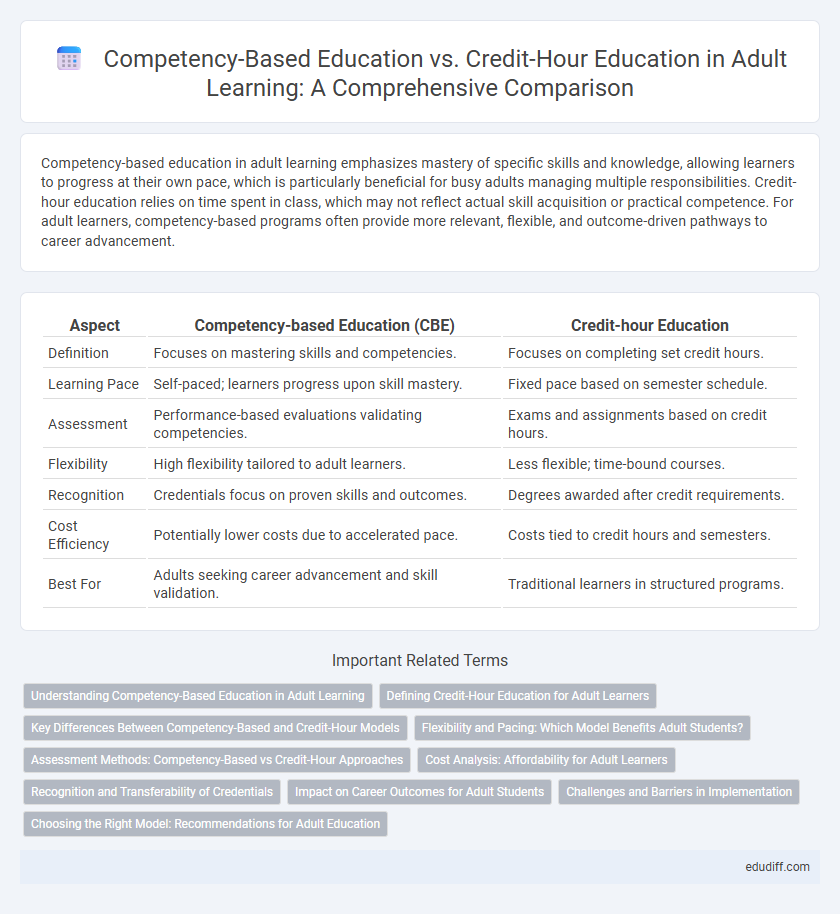Competency-based education in adult learning emphasizes mastery of specific skills and knowledge, allowing learners to progress at their own pace, which is particularly beneficial for busy adults managing multiple responsibilities. Credit-hour education relies on time spent in class, which may not reflect actual skill acquisition or practical competence. For adult learners, competency-based programs often provide more relevant, flexible, and outcome-driven pathways to career advancement.
Table of Comparison
| Aspect | Competency-based Education (CBE) | Credit-hour Education |
|---|---|---|
| Definition | Focuses on mastering skills and competencies. | Focuses on completing set credit hours. |
| Learning Pace | Self-paced; learners progress upon skill mastery. | Fixed pace based on semester schedule. |
| Assessment | Performance-based evaluations validating competencies. | Exams and assignments based on credit hours. |
| Flexibility | High flexibility tailored to adult learners. | Less flexible; time-bound courses. |
| Recognition | Credentials focus on proven skills and outcomes. | Degrees awarded after credit requirements. |
| Cost Efficiency | Potentially lower costs due to accelerated pace. | Costs tied to credit hours and semesters. |
| Best For | Adults seeking career advancement and skill validation. | Traditional learners in structured programs. |
Understanding Competency-Based Education in Adult Learning
Competency-based education (CBE) in adult learning emphasizes mastery of specific skills and knowledge rather than time spent in class, allowing learners to progress at their own pace. This model aligns with adult learners' need for flexibility and practical application, improving retention and relevance by focusing on measurable outcomes. Institutions adopting CBE often integrate real-world experiences and assessments that validate competencies, enhancing workforce readiness and lifelong learning opportunities.
Defining Credit-Hour Education for Adult Learners
Credit-hour education quantifies learning by the number of instructional hours spent in class, traditionally designed for younger students with fixed schedules. Adult learners often face challenges with this model due to its rigid time requirements and limited recognition of prior knowledge or professional experience. Competency-based education offers an alternative by assessing mastery of skills and knowledge, allowing adults to progress at their own pace and leverage existing expertise.
Key Differences Between Competency-Based and Credit-Hour Models
Competency-based education (CBE) measures student learning through demonstrated mastery of specific skills and knowledge, allowing personalized pacing, whereas credit-hour education relies on time spent in class and seat hours as the primary metric of progress. CBE emphasizes real-world application and flexible assessment methods, contrasting with the fixed curriculum and standardized testing typical of credit-hour systems. Institutions adopting CBE often report improved learner engagement and outcomes by focusing on competency acquisition rather than time-based credit accumulation.
Flexibility and Pacing: Which Model Benefits Adult Students?
Competency-based education offers adult learners greater flexibility by allowing them to progress at their own pace based on demonstrated mastery of skills, rather than being bound by fixed credit hours. This model supports individualized learning paths, enabling students to balance education with work, family, and other responsibilities more effectively. In contrast, credit-hour education follows a rigid schedule that may hinder adults needing adaptable timelines for course completion.
Assessment Methods: Competency-Based vs Credit-Hour Approaches
Competency-based education emphasizes mastery of specific skills and abilities assessed through practical projects, portfolios, and real-world problem-solving tasks, ensuring learners demonstrate concrete expertise. Credit-hour education relies on time-based assessments and standardized testing, focusing on seat time and theoretical knowledge rather than applied competence. This distinction influences how adult learners are evaluated, with competency-based methods prioritizing individualized and outcome-focused assessment tailored to real-world applications.
Cost Analysis: Affordability for Adult Learners
Competency-based education (CBE) offers a cost-effective alternative to traditional credit-hour education by allowing adult learners to progress at their own pace, reducing time spent and overall tuition expenses. Studies indicate that CBE programs can lower costs by up to 40% compared to credit-hour models, making higher education more accessible for working adults balancing financial and time constraints. The affordability of CBE is further enhanced through flexible scheduling and targeted assessments that eliminate unnecessary coursework, directly benefiting adult learners seeking efficient pathways to degree completion.
Recognition and Transferability of Credentials
Competency-based education prioritizes mastery of specific skills and knowledge, allowing adult learners to earn credentials based on demonstrated competencies rather than time spent in class. This approach enhances recognition and transferability of credentials across industries and institutions by clearly aligning competencies with employer or academic standards. In contrast, credit-hour education often limits transferability due to varying curriculum structures and time-based credit accumulation, making it less flexible for adult learners seeking to leverage prior learning experiences.
Impact on Career Outcomes for Adult Students
Competency-based education (CBE) offers adult students flexible pacing and mastery of skills directly aligned with workforce demands, often accelerating time-to-degree and enhancing employability metrics. Credit-hour education, traditionally time-based, may delay career advancement due to rigid course schedules and less direct relevance to specific job competencies. Research indicates that adult learners in CBE programs report higher employment rates and salary increases post-completion compared to those in credit-hour models, highlighting CBE's impact on career outcomes.
Challenges and Barriers in Implementation
Competency-based education (CBE) faces challenges such as inconsistent assessment standards, integration difficulties with traditional credit-hour systems, and resistance from faculty accustomed to time-based learning models. Credit-hour education barriers include rigid scheduling, limited personalization, and difficulty accommodating diverse learner paces, which hinder flexible adult learning paths. Both models struggle with technology adoption, administrative complexities, and ensuring alignment with accreditation requirements for quality assurance.
Choosing the Right Model: Recommendations for Adult Education
Competency-based education (CBE) offers adult learners personalized pacing and mastery-focused progress, which aligns well with diverse work and life commitments. Credit-hour education relies on time-based measures, potentially limiting flexibility for adults balancing multiple responsibilities. Selecting CBE can enhance skill application and career advancement by emphasizing demonstrated competencies over seat time.
Competency-based Education vs Credit-hour Education Infographic

 edudiff.com
edudiff.com